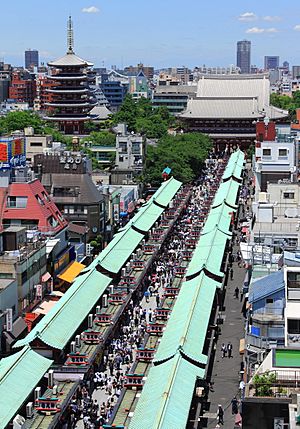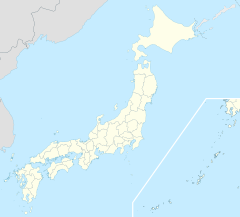Sensō-ji facts for kids
Quick facts for kids Sensō-ji浅草寺 |
|
|---|---|
 |
|
| Religion | |
| Affiliation | Buddhist |
| Sect | Shō-Kannon (independent school) |
| Deity | Shō Kannon Bosatsu (Āryāvalokiteśvara) |
| Location | |
| Location | 2-3-1 Asakusa, Taitō-ku, Tokyo |
| Country | Japan |
| Architecture | |
| Founder | Kaishō |
| Completed | 645 |
Sensō-ji (Japanese: 金龍山浅草寺, Hepburn: Kinryū-zan Sensō-ji) is a very old Buddhist temple in Tokyo, Japan. You can find it in the neighbourhood of Asakusa. It is one of the oldest and most important temples in Tokyo. The temple was first built in 645 CE. The most important figure worshipped here is Kannon Bosatsu. Kannon is also known as Avalokiteśvara.
Sensō-ji has played a big part in Japanese history many times. For example, during the time of the Edo shoguns, Tokugawa Ieyasu was the leader of Japan. He made Sensō-ji the main temple for his family, the Tokugawa clan. Later, many small shops opened in front of the temple. These shops are still there today.
The buildings you see at the temple now are not the original ones. Many of the gates and artworks have been rebuilt after being destroyed.
Contents
History of Sensō-ji Temple
How Sensō-ji Was Built
A legend from the area tells a special story. In the 7th century, some fishermen found a gold statuette of Kannon. They found it caught in their fishing nets in the Sumida River. Sensō-ji was built so people could worship this statuette. The land where Sensō-ji stands was home to a very large Buddhist temple in the 8th century.
Sensō-ji During World War II
During World War II, Japan was fighting the United States. Many Japanese cities were bombed by airplanes. In March 1945, during the Great Tokyo Air Raid, Sensō-ji was badly damaged. Many of its buildings and some art were destroyed. Other parts of Asakusa were also ruined.
Important Parts of the Temple
The Kaminarimon Gate
The Kaminarimon (雷門, "Thunder Gate") is one of the two main gates at Sensō-ji. When people walk through this gate, they are on their way to the main temple building and the Hōzōmon. This gate is about 11.7 metres (38 ft) tall and 11.4 metres (37 ft) wide. It covers an area of 69.3 square metres (746 sq ft). The gate has a huge red lantern hanging from it. This lantern is usually replaced about every 10 years.
The Kaminarimon gate you see today is not the first one. The very first gate was built in 941, during the Heian period. It burned down in a fire in 1865. A new gate was built in 1960. This was possible because Konosuke Matsushita gave money to rebuild it.
The Hōzōmon Gate
The Hōzōmon (宝蔵門, "Treasure-House Gate") is the other big gate at Sensō-ji. It is closer to the main temple building than the Kaminarimon. This gate has two storeys, which is called a nijūmon in Japanese. Many important objects are kept safe inside this gate.
On the left and right sides of the gate, you will see two very large sandals. They are made of straw and are called "ōwaraji," meaning "big waraji" (a type of Japanese sandal). Each sandal is about 4.5 metres (15 ft) long and 1.5 metres (4.9 ft) wide. They each weigh about 500 kilograms (1,100 lb). New sandals are made every 10 years by people from Tateokāramachi. This is a neighbourhood in Murayama, Yamagata. The eighth pair of sandals was made in 2018. The ōwaraji are hung there to protect the temple from anything bad. They also show how strong the statues of Nio are inside the Hōzōmon. The first ōwaraji were put up in 1941. This tradition started because Toshizo Matsuoka, who was part of the Japanese government, gave some straw sandals to the temple.
Nakamise-dōri Shopping Street
The Nakamise-dōri (仲見世通り) is a street right in front of the temple. Along this street, there are many small stores. These shops sell souvenirs and food. The street is about 250 metres (270 yd) long and has 89 shops.
Gallery
-
A beautiful Pagoda with five floors.
Images for kids
-
A wooden carving of a dragon on the bottom of the big red paper lantern on the Kaminarimon.
-
A view of Sensō-ji by Hiroshige.
-
An illustration inside Sensō-ji showing how the two fisherman brothers found the bosatsu Kannon statuette in the Sumida River.
See also
 In Spanish: Sensō-ji para niños
In Spanish: Sensō-ji para niños























